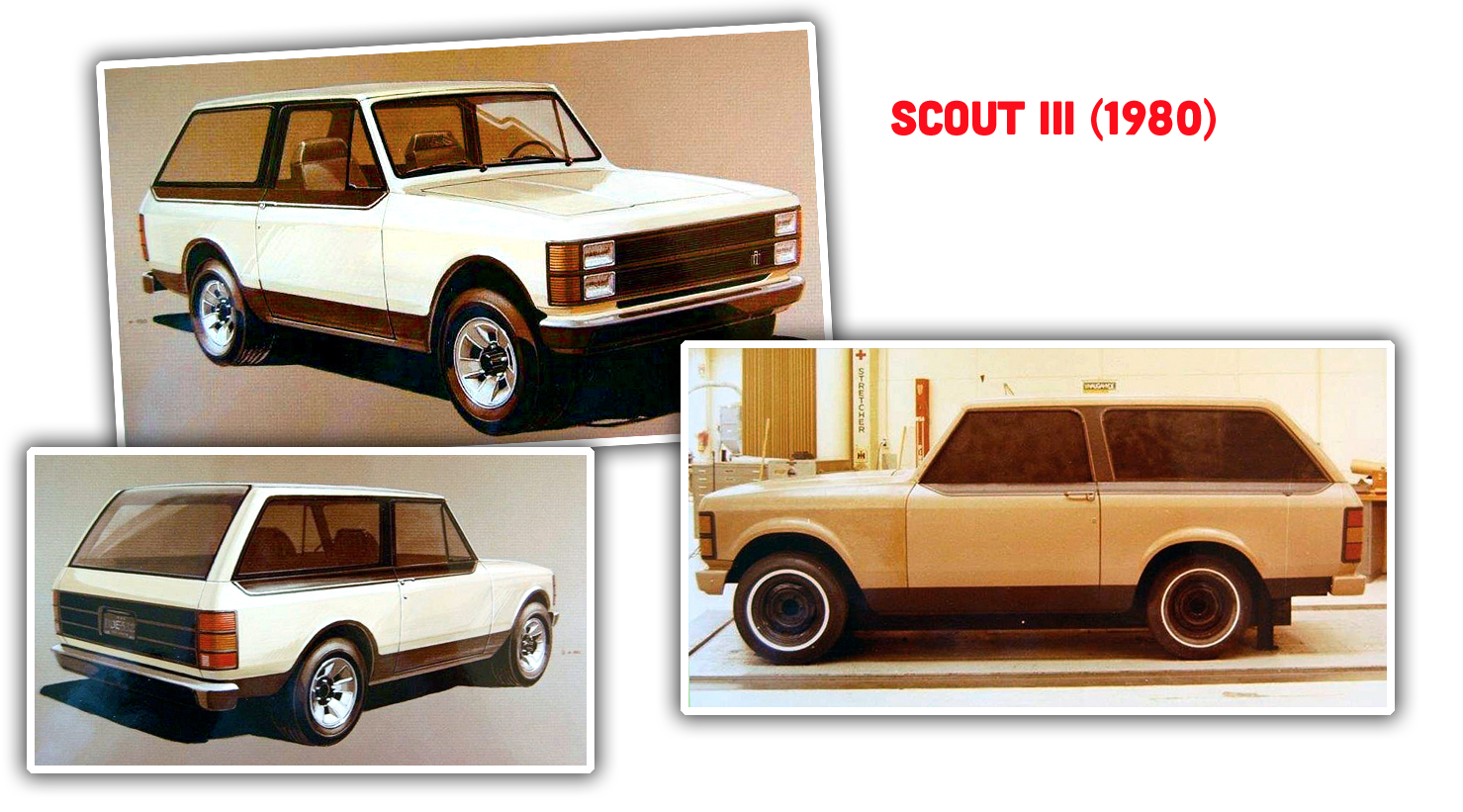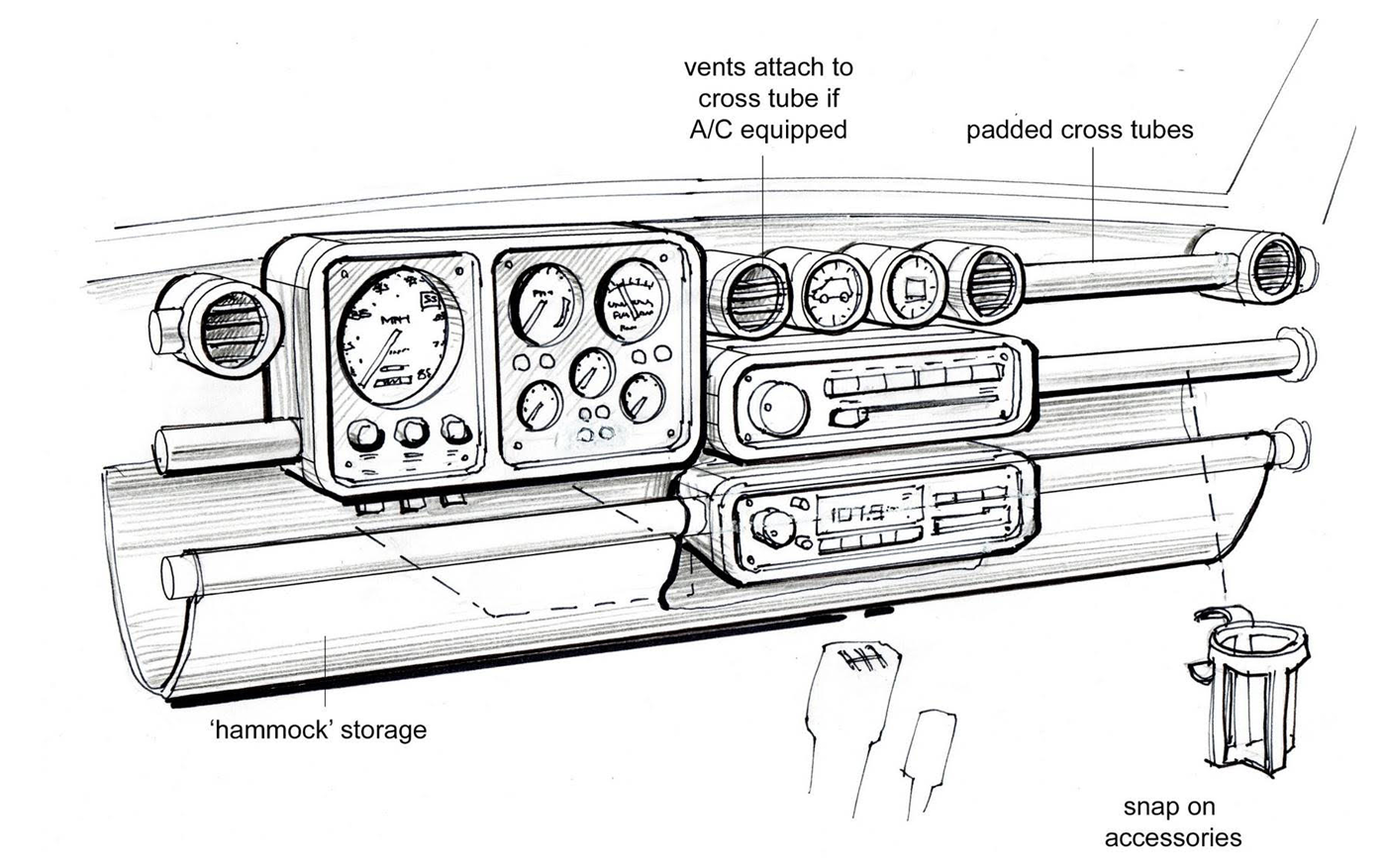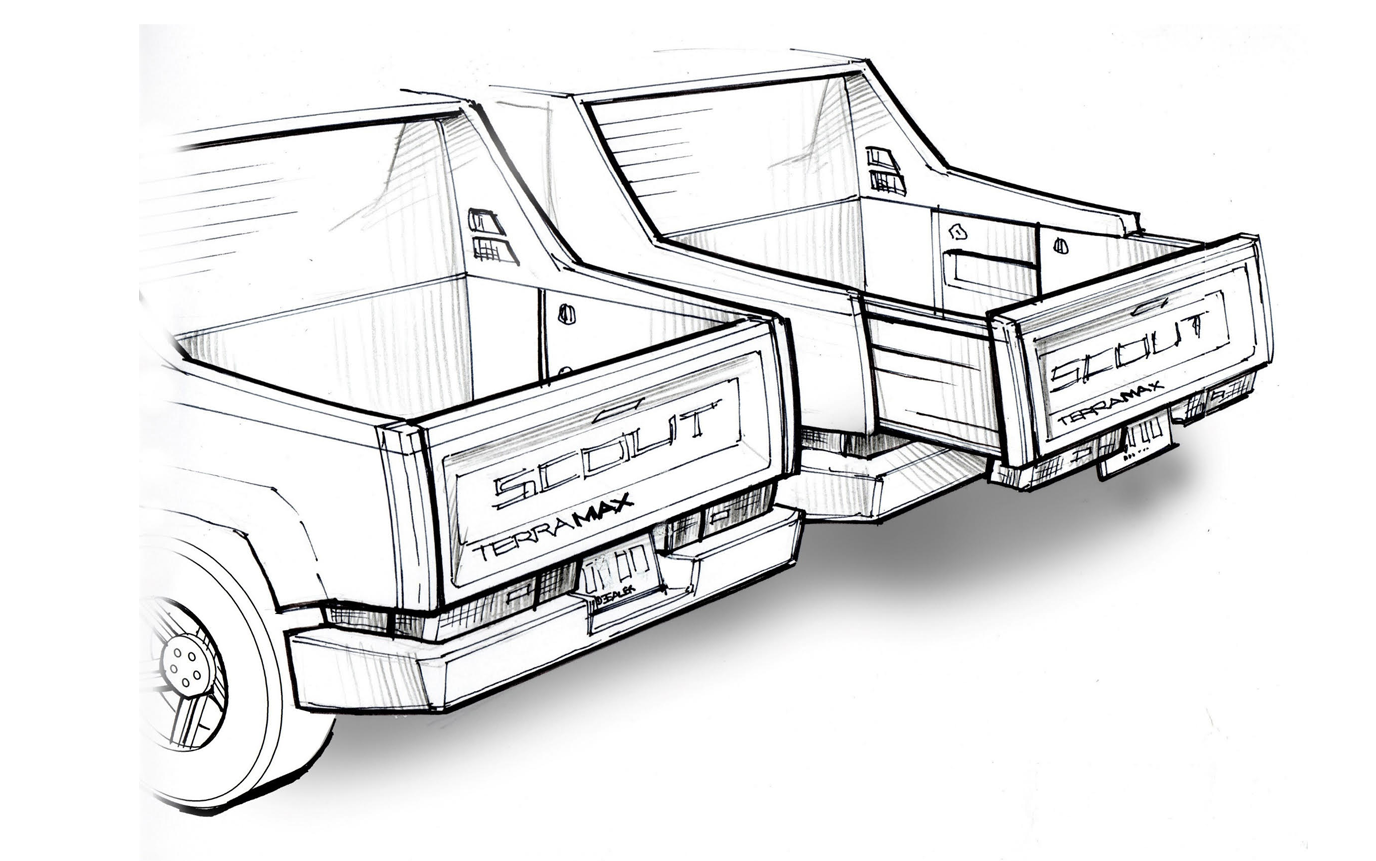First, in case you’ve somehow recently walked into a whirling ceiling fan and forgotten what an International Harvester (IH) Scout is, let’s do a quick refresher. International Harvester, as the name suggests, started as a farm equipment company, but moved into building trucks pretty early in the 1900s. They expanded to passenger cars with the Travelall, and then in the late 1950s decided they needed a competitor to the Jeep, which was riding its WWII fame to become a staple of off-road civilian life. Originally conceived as a plastic-bodied car, the scout was designed by IH Chief Designer Ted Ornas, who came up with the final design in 1958 on his kitchen table, on a scrap of mat board.
That sketch was approved, the project switched from plastic to steel, and by 1961 there were Scouts being sold. The Scout was a success, with a second-gen version, the Scout II, arriving in 1971 and lasting until the nameplate’s demise in 1980. Over half a million Scouts were sold over the years, making it likely IH’s best-known car. In 1979, International built a concept car called the Supplemental Scout Vehicle (SSV) that pointed to the future direction of the Scout, except it, you know, didn’t have a future. You can get a sense of where IH was thinking about going with the Scout which, interestingly, included a return to a non-steel body. Unfortunately, a number of factors including the increased demand for more fuel-efficient cars and IH needing to focus more on the product lines that actually made money, their trucks, caused the Scout program to be ended.
Before it ended, there were styling studies for an updated Scout III, but, of course these never happened. And that’s where The Bishop comes in. Our designer of Cars That Never Happened picks up the Scout story in 1987, when an all-new Scout was designed, with an emphasis on its off-road roots, and a design that seems to have been inspired by the 1979 SSV concept:
The rugged, unpainted lower-body cladding feels like the right choice for a car that’s going to get lots of off-road abuse, and I think the overall look certainly works in a late-’80s tough context. What I really like best about The Bishop’s ’87 Scout IV (?) design are all the clever details, though:
There’s a winch behind the front license plate, which folds down, and the idea of “folding” is carried throughout so much of the car: lights on the roll bar fold up, a bumper step folds down (also, I adore the use of a spare tire as an additional bumper element) and that rear fastback soft top folds up and out of the way, into the roll bar, in a very clever variant on the usual soft top theme. Inside, at the rear–well, I guess it’s only sort-of inside, with the roof panel off and the soft top folded up–we have all kinds of other foldy goodness going on:
Those crank-operated roof lights! And look at the fantastic way the seats fold flat to form a cargo bed! It reminds me a bit of how the VW Thing’s rear seats folded down to make a cargo platform, just more refined:
Plus, the idea that you could remove the seat cushions to make a pair of enclosed storage bins? Brilliant. Like all good off-roaders, the Scout should be able to shed its doors, easily, and The Bishop has come up with a very clever, tool-free method:
I suppose how well this all works is dependent on how much IH cheaped out or not on the materials; if those turn lock mechanisms are cheap plastic, these would become a nightmare, but if they’re actually metal, then we’ve got something here. My favorite bit, though, might be this dash concept:
Those cross-beams would house separate instrument or radio or HVAC or vent units or whatever; if you have AC, then that top tube would be hollow, with ports for the vents. There’s a hammock-like thing that acts as a glove box for your stuff, too. Plus, the cross-bars would have a known diameter, so aftermarket companies could easily make clip/snap on accessories of all kinds. It’s sort of like the dash design of a Fiat Panda, just a bit more industrial:
The Bishop’s feverish imagination went on to concoct a whole line of these Scout-based vehicles, including long-wheelbase replacements for the old Travelall and pickup trucks:
I especially like that drawer-like slide-out bed extender, which he sketched in more detail:
I guess maybe a fold-over section of the bed floor would flop backwards to make the floor of the extended portion? It seems pretty clever to me. Those taillights would need extendible wiring, though, and I could see that wearing out and being a constant pain once these things started getting old. Regardless, this Scout That Wasn’t is full of some great ideas that I hope smart designers from major automakers are looking to steal as we speak. More folding stuff on our SUVs, carmakers! It’s what the people want! Also try to imagine how much creaking noise it will make in the cabin, when the hard plastic of the “modular” pods rub against each other. It looks very cool, but a one pice dashboard with as few part as possible is just better. Take a lot at an old VW Beetle or a ten year old Toyota Aygo, for a lesson in simplicity. I DO love the looks of the modular instruments, and it reminds me of something from the Alien 1979 movie. And I think it WOULD work in a spaceship floating through outer space. If the thrusters are not on full boost, the vibration in the cockpit would be minimal. Much unlike in an IH Scout. In the Mk1 Panda, the only loose modular thing was the ashtray. It was made in the strange soft brown Fiat 80ies plastic and also mounted on the canvas covered bar holding the hammock tray, so vibrations were softened. But it was VERY cool, that it could slide from side to side to whoever was smoking at the time. The Panda also came with TWO folding canvas flaps in the roof! Also, while we’re talking about International Harvester, I saw a Travelall at a car show recently with FOUR (4) fuel tanks: two in the rear, and one in each front fender. I can’t find many details online about this option. Any Autopians have any additional insight here? There were also several options for additional rear tanks of different sizes and locations for the pickup and the Travelall as well, for anyone anticipating the need to carry serious amounts of fuel. I’d also love to see a rigid aluminum bed cover that goes straight up and down (via electric motor) mounted to 2” square pipe that periscopes up out of the stake pockets in each corner of the truck bed. I’ve wanted this for years, along with the tailgate slide-out or something similar pictured here. And fold down bedsides – or side gates, if you will. I’m going to mock the concept up in SketchUp and report back in a few days. Stay tuned. I came close to buying a relatively low-rust one off Craigslist a few years ago (probably about 1/4 of a Tracy) but I ultimately chickened out due to them being uncommon enough that I was afraid parts would be hard to find. Instead of being a fixed amount, the size of a square tracimeter would be dictated by and relative to the overall size of the vehicle in question, whose surface area in its totality would be made up of 100 square tracimeters. One hundred square tracimeters would equate to one “metric detre.” (David + Tracy + beater = detre). I’m using the Queen’s English to spell “detre” so that the term is not confused with the transitive verb “deter” – although should you ever encounter a true metric detre, you should most certainly be deterred. A metric detre, the theoretical limit of vehicular rust, would be an automobile that is absolutely, completely, 100% covered in rust. As an alternative to “square tracimeters,” I’d also be open to using the term “square datrameters.” All those in favor, say “aye” or… ya know, gimme a thumbs up. It goes without saying that you don’t want to consider taking on a project car that is greater than one Tracy, because then you’re in the territory of that one from the “60 for 60” video that someone had bolted on a length of angle iron as a “replacement” for part of the frame. It isn’t that cars can’t go >1 Tracy, it’s just that those that do are typically no longer on the road. But if we want to be more scientific about it, your way sounds good too. https://en.wikipedia.org/wiki/Monteverdi_Safari This is the true “Scout III” in my book. And it looks so good! If I had the cash, I’d import one. Yes to the similarity to a range-rover; not an accident, I think. (The Sarah is just as great, frankly.)












